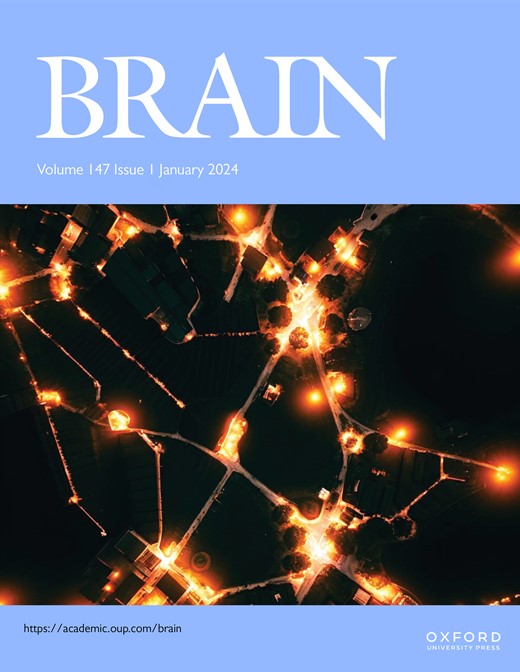Medial temporal lobe lesions reduce visual working memory precision
IF 11.7
1区 医学
Q1 CLINICAL NEUROLOGY
引用次数: 0
Abstract
Classic lesion case-control studies suggest minimal involvement of the medial temporal lobe (MTL) in visual working memory (VWM), particularly for simple stimulus features like color or orientation. However, recent intracranial recordings implicate the MTL – especially the hippocampus – in supporting VWM precision by distinguishing similar visual features to reduce representational variability during short retention intervals. Meanwhile, reports that MTL activity scales with VWM set size have raised the possibility that the MTL contributes not only to the quality but also the quantity of retained VWM content – an idea motivated by models positing a unitary memory strength metric to account for behavioral expressions of both VWM quantity and quality. To clarify the extent to which MTL lesions affect VWM quality, quantity, or both, we examined VWM recall performance in 40 neurological cases with drug-resistant epilepsy before and after their brain surgery for seizure treatment. Of these, 19 had lesions involving the hippocampus, while 21 had either no lesions or lesions outside the hippocampus. Using a controlled VWM task with fixed set size and minimal non-target recall errors, we modeled participants’ recall responses to estimate recall variability as an inverse measure of VWM precision and the probability of recall success as the proportion of trials not attributable to failed, uniform recall responses. We found that lesions affecting the hippocampus in the MTL led to a significant increase in recall variability, indicating reduced VWM precision after surgery. Voxel-based lesion-symptom mapping further revealed a robust association between hippocampal damage and increased recall variability, even after controlling for overall brain lesion volume. In contrast, total lesion volume – but not hippocampal lesion extent – predicted reduced recall success rate, suggesting that broader lesion burden constrains how much content is retained, resulting in more failed recall responses. An alternative model assuming a unitary memory strength metric captured the overall performance decline with increasing total lesion volume but could not account for the MTL-specific effects. Together, these findings highlight the MTL’s role in preserving the fidelity – rather than the mere presence – of VWM representations. They challenge models that treat VWM quality and quantity as interchangeable consequences of a single underlying memory strength parameter. By identifying distinct neural correlates for each component, our results point to VWM precision as a sensitive behavioral marker – one that may be useful for tracking functional changes in individuals with memory impairment, including those with focal brain lesions.内侧颞叶病变降低视觉工作记忆精度
经典的病变病例对照研究表明,内侧颞叶(MTL)在视觉工作记忆(VWM)中的作用最小,特别是对于简单的刺激特征,如颜色或方向。然而,最近的颅内记录表明,MTL——尤其是海马体——通过区分相似的视觉特征来减少短保留间隔内的表征变异性,从而支持VWM的准确性。与此同时,有报道称,具有VWM集大小的MTL活动量表提出了MTL不仅对保留的VWM内容的质量有贡献,而且对保留的VWM内容的数量也有贡献的可能性——这一想法是由假设一个统一的记忆强度指标来解释VWM数量和质量的行为表达的模型所激发的。为了阐明MTL病变对VWM质量、数量或两者影响的程度,我们检查了40例神经系统耐药癫痫患者脑外科手术前后的VWM回忆表现。其中,19人有涉及海马的病变,21人要么没有病变,要么在海马之外有病变。使用固定规模和最小非目标回忆错误的受控VWM任务,我们对参与者的回忆反应进行建模,以估计回忆可变性作为VWM精度的逆度量,以及回忆成功概率作为不归因于失败的统一回忆反应的试验比例。我们发现,影响MTL海马的病变导致回忆变异性显著增加,表明手术后VWM精度降低。基于体素的损伤症状映射进一步揭示了海马损伤与记忆变异性增加之间的强大关联,即使在控制了整个脑损伤体积之后也是如此。相反,总的病变体积——而不是海马的病变范围——预示着回忆成功率的降低,这表明更大的病变负担限制了记忆内容的多少,导致更多失败的回忆反应。另一种假设单一记忆强度指标的模型捕获了随着总损伤体积增加而出现的整体性能下降,但无法解释mtl的特定影响。总之,这些发现强调了MTL在保持VWM表征的保真度(而不仅仅是存在)方面的作用。它们挑战了将VWM质量和数量视为单个潜在内存强度参数的可互换结果的模型。通过识别每个组成部分的不同神经相关性,我们的研究结果表明VWM精度是一种敏感的行为标记,可以用于跟踪记忆障碍患者的功能变化,包括那些有局灶性脑损伤的人。
本文章由计算机程序翻译,如有差异,请以英文原文为准。
求助全文
约1分钟内获得全文
求助全文
来源期刊

Brain
医学-临床神经学
CiteScore
20.30
自引率
4.10%
发文量
458
审稿时长
3-6 weeks
期刊介绍:
Brain, a journal focused on clinical neurology and translational neuroscience, has been publishing landmark papers since 1878. The journal aims to expand its scope by including studies that shed light on disease mechanisms and conducting innovative clinical trials for brain disorders. With a wide range of topics covered, the Editorial Board represents the international readership and diverse coverage of the journal. Accepted articles are promptly posted online, typically within a few weeks of acceptance. As of 2022, Brain holds an impressive impact factor of 14.5, according to the Journal Citation Reports.
 求助内容:
求助内容: 应助结果提醒方式:
应助结果提醒方式:


